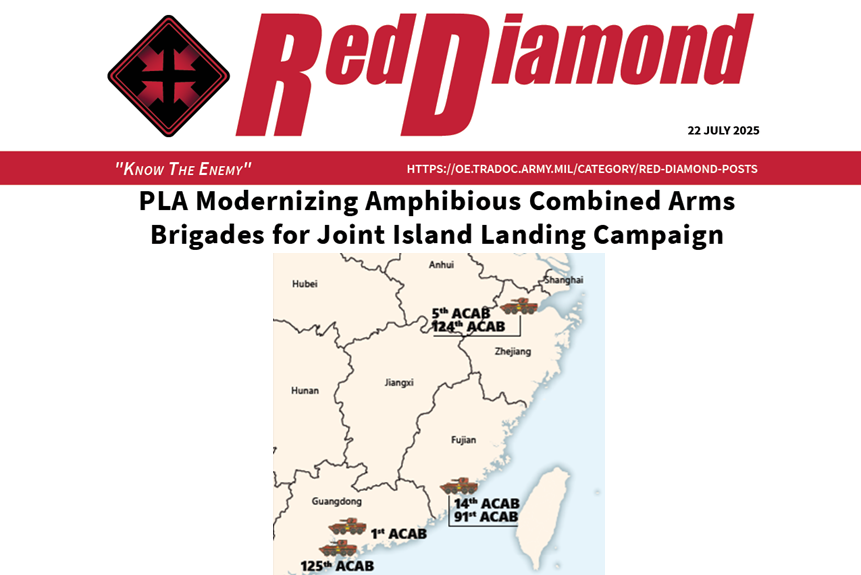
PLA Modernizing Amphibious Combined Arms Brigades for Joint Island Landing Campaign
By N. Luke Roth
The People’s Liberation Army’s (PLA) ability to successfully conduct a joint island landing campaign (JILC) relies on its amphibious combined arms brigades (ACABs), China’s primary assault force, which are undergoing rapid modernization to address operational challenges. These units are designed to serve as the initial landing force in a JILC, leveraging a flexible, module structure to tailor capabilities for specific missions. They uniquely focus on using high-speed amphibious vehicles and combined arms integration in a littoral environment.
The changes the PLA has made in its ACABs since 2017 strongly suggest they are meant to serve as the primary landing force in a JILC.1 Prior to a significant reorganization in 2017, the PLA Army maintained three amphibious units along China’s east coast—two divisions and one brigade. Reflecting a broader shift in force structure, the 1st Amphibious Mechanized Infantry Division and the 124th Amphibious Infantry Division were disbanded and reformed into two of the ACABs that we recognize today. Additionally, the 14th Amphibious Armored Brigade was converted, and a sixth ACAB was created through reequipping parts of the former 91st Motorized Infantry Division in Zhangzhou. A few of the new ACABs were relocated from their previous garrison locations to new regions, sometimes crossing former military boundaries.2 Four ACABs are now under the Eastern Theater Command and two are under the Southern Theater Command (see Figure 1). With their reallocation these units are strategically positioned and increasingly focused on training near Taiwan.3 Each ACAB includes a separate battalion dedicated to reconnaissance, fires, air defense, and logistical support.4
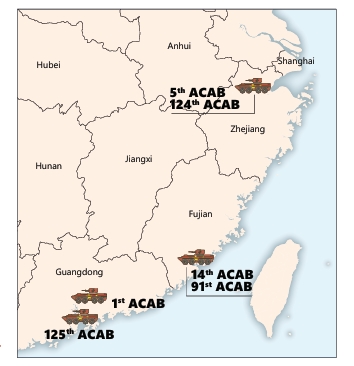
![]()
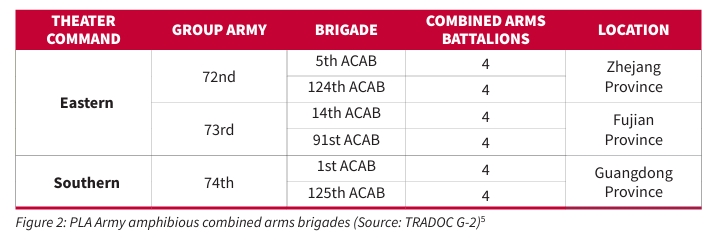
PLA’s ACAB Design
Each ACAB uses a flexible, modular design allowing commanders to select specific combat and support units to build a force tailored for each mission. This structure allows each brigade to seamlessly integrate and leverage its senior Group Army for fire support, air defense, air transport, aerial fire support, intelligence, and other capabilities.6 The plug-and-play approach extends from the ACAB to its four amphibious combined arms battalions, each of which are equipped with advanced gear, including the latest Type-05 amphibious chassis vehicles, assault vehicles, infantry fighting vehicles, engineering vehicles, and howitzers.7 These battalions form the foundation of the brigade’s operational effectiveness.8
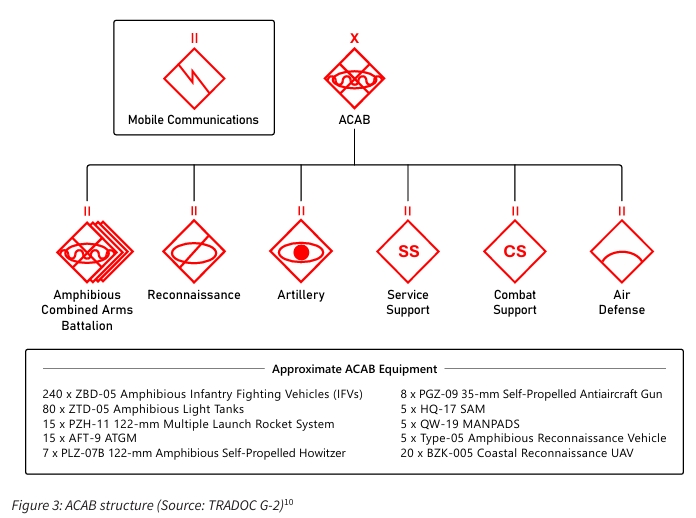
The ACAB design was inspired by the land-based heavy combined arms brigades and has been compared to the U.S. Army’s armored brigade combat teams (ABCT) structure. Instead of relying on traditional tanks and armored personnel carriers, however, ACABs are equipped with modern and highly capable amphibious assault guns and amphibious infantry fighting vehicles, all designed for high water speed.9 Each ACAB consists of approximately 5,000 personnel and over 400 vehicles. This capacity is crucial for planning amphibious operations and determining the necessary shipping requirement.
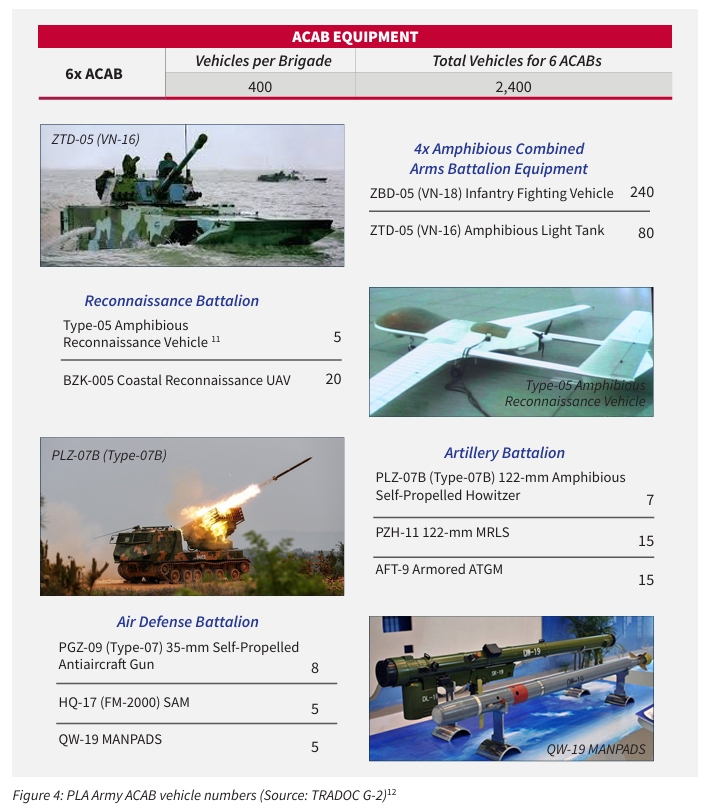
China heavily invests in improving its fleet of high-water-speed amphibious armored vehicles to execute the rapid, sustained assaults required for a JILC. Chinese defense entities, commercial companies, and PLA organizations have filed dozens of patent applications with the U.S. Patent and Trademark Office aimed at enhancing water speed, streamlining transitions between water and land, improving maintenance, reducing corrosion, improving land mobility, and boosting operational safety.13 Other areas of improvement include steering, training, manufacturing, heat dissipation and cooling, engine control and performance, managing cavitation, and vehicle design.14 Early iterations of the Type-05, dating back to 2000, reportedly had substantial deficiencies, such as the lack of a panoramic view for the commander and the inability to effectively fire on the move.15 Newer generations, however, primarily those developed by Norinco Corporation, have addressed these problems and boosted engine power, significantly improving speeds.16
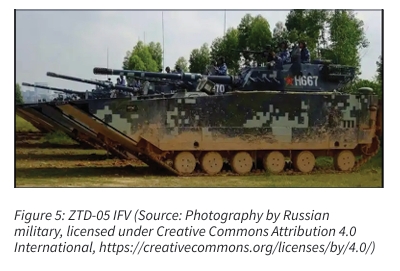
In addition to providing world-class amphibious capabilities, the vehicles project significant weaponry and tonnage. The current vehicle family includes the ZBD-05 amphibious infantry fighting vehicle17 armed with a 30-mm cannon, antitank missiles, and a machine gun, weighing 26.5 tons and able to carry a crew of three plus eight infantrymen. The family also includes the ZTD-05 amphibious light tank18 which features a powerful 105mm cannon operable even while afloat, along with a heavy machine gun.19 The Type-05 vehicle platform also provides command and control, support, and reconnaissance variants and features a design concept comparable to the canceled U.S. Expeditionary program.20 Typically deployed from transport vessels several kilometers offshore, Type-05s also possess the capability to traverse bodies of water independently, with speeds up to 45 kilometers per hour, potentially enabling assaults from mainland China to Taiwan’s outlying islands.21
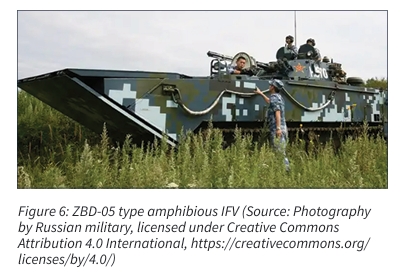
PLA Joint Amphibious Training Increases
Amphibious training has increased in frequency and complexity since the PLA Army implemented semiannual conscription, indicating the importance of these exercises. Training events typically occur during optimal weather months from March to October and often involve units at battalion or below.22 The three largest training areas are Dongshan Island in southern Fujian Province, Dacheng Bay near the Fujian/Guangdong provincial border, and near Shanwei in Guangdong Province. Dacheng Bay is large enough to accommodate an entire ACAB, while the other locations are more suitable for battalions. Core training tasks include personal survival swimming, vehicle driving, maintenance, rescue and recovery, loading/unloading vehicles onto landing craft onshore or PLA Navy amphibious ships anchored offshore, assault beach landings using amphibious vehicles, shore landing by troops in small (squad-size) motorboats, offshore/onshore clearance operations, and movement inland to destroy enemy forces.23

Amphibious battalion joint-landing drills show support from brigade, group army, and naval assets in a coordinated, multidomain approach.24 Videos released by the PLA illustrate the full scope of training, from loading amphibious ships both in port and offshore, day and night operations. Videos detail small teams using UAV conducting initial reconnaissance of landing beaches. surface vessels clear obstacles in the water approaching the landing beaches, and reconnaissance and engineer troops land in small motorboats to remove beach obstacles.25 Amphibious fighting vehicles disembark from PLA Navy amphibious ships to assault the shore and establish a beachhead. Helicopters insert special operations forces troops beyond the beach, and armored amphibious units move inland to capture key terrain and infrastructure, with small, unmanned reconnaissance robots advance further inland.26 Supporting elements include artillery fire from 122-mm howitzers and multiple rocket launchers, and attack helicopters from the group army aviation brigade to engage targets near the beach and transport troops beyond the shoreline.27
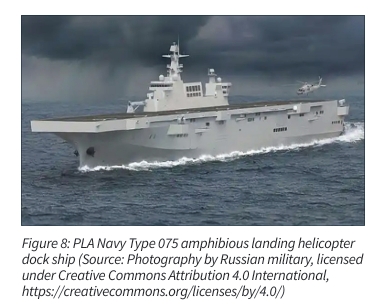
PLAN May Prove ACABs’ Achilles’ Heel
If the PLA Army carries out an amphibious invasion of Taiwan, it will rely heavily on PLA Navy sealift capabilities to deploy ACABs and support beachhead lodgment.28 The Type-071 has a vehicle deck and a well deck that can house up to 60 armored fighting vehicles, including amphibious assault vehicles like the ZBD-05 infantry fighting vehicle, the ZTD-05 light tank, and other variants.29 The Type-075 is larger than the Type-071 and can carry up to 30 helicopters, 60 armored vehicles, and 800 troops. It has a specialized well deck for launching Type-726 Landing Craft Air Cusion (LCAC) (hovercraft) and amphibious assault vehicles. The Type-726 LCAC (NATO reporting name Yuyi class) is a class of air-cushioned landing craft used by the PLA Navy Marine Corps and ACABs.30
The PLA Navy has limited amphibious lift capacity given that the majority of its ships are designed for other mission sets, so it cannot simultaneously transport all ACAB forces and meet the needs of the PLA Navy Marine Corps. The current fleet comprises eight Type-071 ships, three active Type-075 ships (one additional ship still in construction), and approximately several dozens of landing ship mediums, which are unevenly distributed across the Northern, Eastern, and Southern Theater Commands.31 Moreover, the manning and equipment of each ACAB significantly exceeds the capacity of PLA Navy landing ships. Consequently, a combined fleet of PLA Navy and PLA Army watercraft as well as modified merchant ships will be required to transport ACAB forces to Taiwan’s coastline. This fleet will also need to sustain them until they secure beach landing zones or a suitable port.32
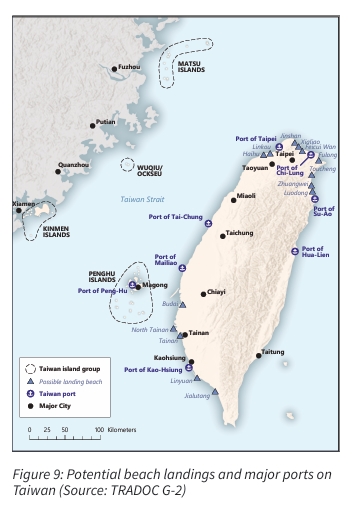
Implications for Large-Scale Combat Operations
A cross-Straight invasion is most likely March-October. Outside this period, the weather and sea conditions are too unpredictable for a sea-based amphibious landing operation. Additional challenges to a cross-Strait invasion would include shallow seas in and around Taiwan’s shoreline, thousands of sea mines scattered over a large area of ocean surrounding Taiwan, and the threat of Taiwanese torpedoes and cruise missiles. The limited number of beach landing options are well-known to Taiwanese defense planners and are heavily fortified to resist invasion.33 Given the restricted environment, even successful ampihbious assaults on targeted beachheads will depend heavily on follow-on operations involving paratroopers, airlift, and special forces to move inland. These forces can expect to face obstacles, defensive resistance, rugged mountain terrain, and dense urban areas, complicating operations to move inland. These forces will conduct assault operations to capture coastal ports of entry, airfields, other key terrain, and objectives nearer to the core of Taiwan’s defenses. This strategy is intended to facilitate the rapid insertion of second-echelon forces by sea and air.34 If Taiwan decides to destroy major ports to prevent China from securing and using them, PLA Army amphibious
forces may deploy amphibious bridging barges to rapidly insert its echelon forces.35
China’s growing military capabilities—particularly in precision-strike systems, logistics innovation, and anti-access technologies—pose escalating threats to U.S. and allied operations, especially in scenarios involving Taiwan and contested amphibious assaults. By augmenting its vast arsenal of area-effect weapons with an increasingly sophisticated stockpile of precision-guided munitions, China demonstrates a dual-capability strategy designed to disrupt enemy maneuver elements and support units before close combat begins.
- Area vs. Precision. China is rapidly advancing its precision-guided munitions stockpiles to complement its vast arsenal of area-effect weapons, enhancing its ability to conduct multidomain precision strikes while maintaining the flexibility to mass fires. This threatens ABCT maneuver elements and support units, potentially disrupting operations and inflicting heavy casualties before close combat is even joined.
- Contested Logistics. While China possesses long-range lethal fires and global nonlethal capabilities that can disrupt an adversary’s logistics, sustaining large-scale amphibious operations—specifically those undertaken by the ACABs—presents significant logistical challenges for the PLA, including supply chain management and casualty evacuation. The PLA attempts to mitigate these challenges with the use of civilian vessels and advanced barge systems; however, this reliance introduces a separate set of vulnerabilities.
- Antiaccess/Area Denial (A2/AD) Capabilities. While the PLA possesses A2/AD capabilities—anti-ship missiles and air defense systems—that can challenge U.S. and allied forces’ ability to intervene in a Taiwan conflict, these same systems necessitate that the PLA neutralize Taiwan’s defenses before attempting an amphibious assault. Taiwan is equipped with advanced technologies, however, such as U.S.-supplied Harpoon missiles and Patriot systems, which pose a significant threat and require effective countermeasures
- Magazine Depth and Range. China’s domestic manufacturing base can produce vast quantities of military equipment and supplies, which will give the PLA a significant advantage, especially regarding Taiwan. The PLA fields a wide range of sophisticated ATGMs, including long-range, top-attack, and tandem-warhead variants. ACABs will receive support from these weapons, potentially employed by dispersed infantry, and from attack helicopters, posing a significant threat to even the most heavily armored U.S. vehicles.
Notes
1 Blasko, Dennis J. “The PLA Army Amphibious Force, China Maritime Report No. 20,” China Maritime Studies Institute (April 2022).
2 Blasko, Dennis J. “The PLA Army after ‘Below the Neck’ Reforms: Contributing to China’s Joint Warfighting, Deterrence and MOOTW Posture,” Journal of Strategic Studies (2021).
3 Erickson, Andrew. “Chinese Amphibious Warfare: Prospects for a Cross- Strait Invasion,” CMSI (2024).
4 Arostegui, Joshua. “PLA Army and Marine Corps Amphibious Brigades in a Post-Reform Military.” CAPS-RAND Conference (2020).
5 Ibid.
6 Ibid.
7 Blasko, Dennis J. “The PLA Army Amphibious ForcIe, China Maritime Report No. 20,” China Maritime Studies Institute (April 2022).
8 Haver, Zoe. “Speeding Toward Taiwan: China’s Amphibious Armored Vehicles Development,” Recorded Future, Insikt Group (August 15, 2024).
9 Arostegui, Joshua. “PLA Army and Marine Corps Amphibious Brigades in a Post-Reform Military,” CAPS-RAND Conference (2020); Haver, Zoe. “Speeding Toward Taiwan: China’s Amphibious Armored Vehicles Development,” Recorded Future, Insikt Group (August 15, 2024).
10 Data source: Asian Studies Detachment. Report number ASD23C81016. 7 April 2023.
11 Janes. “New Type 05-based amphibious reconnaissance vehicle in PLA service,” (2020) https://customer.janes.com/search?pg=1&q=New%20Type%2005-based%20amphibious%20reconnaissance%20vehicle%20in%20PLA%20service
12 Ibid.13 Haver, Zoe. “Speeding Toward Taiwan: China’s Amphibious Armored Vehicles Development,”
Recorded Future, Insikt Group (August 15, 2024).
14 Ibid.
15 DOD. “China: New Generation of ‘Amphibious Armored Assault Vehicles’ Travel Faster, Equipped with More Firepower,” Osiris (03March25). https://osiris.opensource.gov/documents/1902/78c37580-eaba-4722-bf02-d9bc931282dc
16 Ibid.
17 DOD. “China: New Generation of ‘Amphibious Armored Assault Vehicles’ Travel Faster, Equipped with More Firepower,” Osiris (03March25). https://osiris.opensource.gov/documents/1902/78c37580-eaba-4722-bf02-d9bc931282dc
18 WEG. “ZTD-05 (VN-16) Chinese Amphibious Light Tank,” (Updated May 2025). https://odin.tradoc.army.mil/Search/WEG/ZTD-05%20amphibious%20light%20tank19 Haver, Zoe. “Speeding Toward Taiwan: China’s Amphibious Armored Vehicles Development,”
Recorded Future, Insikt Group (August 15, 2024).
20 Arostegui, Joshua. “PLA Army and Marine Corps Amphibious Brigades in a Post-Reform Military,” CAPS-RAND Conference (2020)
21 Arostegui, Joshua. “PLA Army and Marine Corps Amphibious Brigades in a Post-Reform Military,” CAPS-RAND Conference (2020).
22 Erickson, Andrew. “Chinese Amphibious Warfare: Prospects for a Cross- Strait Invasion,” CMSI (2024).
23 Erickson, Andrew. “Chinese Amphibious Warfare: Prospects for a Cross- Strait Invasion” CMSI (2024).
24 Ibid.
25 Ibid.
26 Ibid.
27 Ibid.
28 Ibid.
29 TRADOC. “Type 071 Amphibious Transport Dock.” WEG (December 2024).
30 TRADOC. “Type 075 Amphibious Landing Helicopter Dock,” WEG (December 2024).
31 Kennedy, Conor. “Getting There: Chinese Military and Civilian Sealift in a Cross-Strait Invasion,” NDU (2022). & Vavasseur, Xavier. “China Launches 4th Type 075 LHD for the PLAN,” Naval News (December 2023) https://www.navalnews.com/naval-news/2023/12/china-launches-4th-type-075-lhd-for-the-plan/
32 Ibid.
33 Blasko, Dennis J. “The PLA Army Amphibious Force, China Maritime Report No. 20,” China Maritime Studies Institute (April 2022).
34 Ibid.
35 Luck, Alex. “Stairway To Taiwan – The Chinese Amphibious Bridging System,” Naval News (Mar2025) https://www.navalnews.com/naval-news/2025/03/stairway-to-taiwan-the-chinese-amphibious-bridging-system/
Distribution A: Approved for public release
Categories:
Tags:
PLA Modernizing Amphibious Combined Arms Brigades for Joint Island Landing Campaign
By N. Luke Roth
File Size:
3MB
File Type:
Page Count:
9

